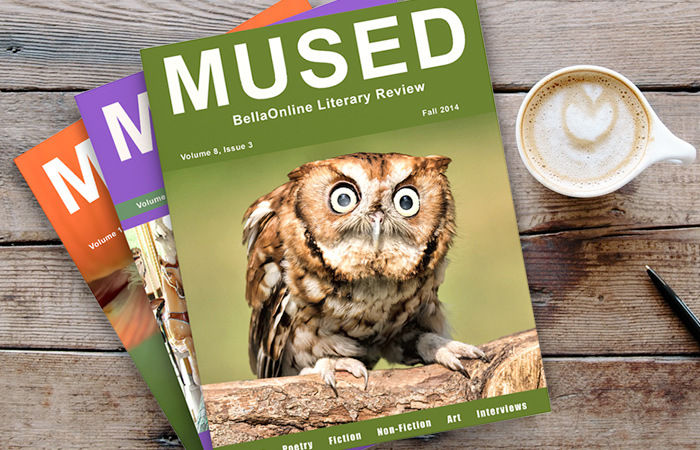-

-
Poetry Submission Information
Poetry Submission Guidelines
Poetry Types
Rhyming Poem Guidelines
Poetry Cliches to Avoid
Creating Immersive Poetry
Showing vs Telling Poetry
Poetry Submission Form
Main Submission Guidelines
General Mused Submission FAQs
Mused Contributor Bio and Photo
Calculating a Word Count
Proofreading Your Submission
Rhyming Poem Guidelines
Sometimes we are asked why Mused has only a few rhymed poems in each issue. The answer is that few people submit rhymed poems, and that they are much harder to write well compared with an unrhymed poem. A poet who writes an unrhymed poem only has to worry about their words and visions and story. They can use whatever words they want. A poet who writes a rhymed poem has an exponentially more difficult challenge ahead of them. Now not only do they have to use words that bring the poem to life, but those words also have to fit tightly into a certain rhyme scheme and a syllable count as well. Only a few poets are able to pull this extra level of challenge off.There are many choices out there for how to structure your rhyming poem. For example, you could use a sonnet style, like when William Shakespeare wrote this sonnet which has the alternating lines rhyme:
Shall I compare thee to a summer's day?
Thou art more lovely and more temperate:
Rough winds do shake the darling buds of May,
And summer's lease hath all too short a date:
Read the poem out loud. You can see how every other syllable has emphasis on it.
Shall I compare thee to a summer's day
This kind of rhythm is important in a rhyming poem, and it can be really challenging to find words that create that rhythm naturally, and that still have meaningful words in them. If you write a typical poem in one day, it can take a month before you get the rhyming version to work out properly!
You can go even more complicated, as Edgar Allen Poe did in his famous poem "The Raven":
Once upon a midnight dreary,
while I pondered, weak and weary,
Over many a quaint and curious
volume of forgotten lore,
While I nodded, nearly napping,
suddenly there came a tapping,
As of some one gently rapping,
rapping at my chamber door.
In this poem, the first and second line of each stanza rhyme with each other, and then the last line of each stanza rhymes. Once again, when you read it you feel the up-down rhythm of the words:
Once upon a midnight dreary
It is very important in a rhymed poem that you read your work aloud and you feel that rhythm, and that the rhymes work properly. A key to this is that the poem feel *smooth*. It should not feel forced - it should not feel like you stuck a really inane word into the poem just to make the rhyme work. Yes, it takes a lot of effort to find the proper words that all fit the poem well! That is why rhymed poems are so rare in this world - and so precious.
For a great example of a rhyming poem which reads smooth as silk when read aloud, check out:
Stopping My Alarm on a Monday Morning by Carole Davis
Word Choice in Rhyming Poems
Once you start to get the rhyme down smoothly, you run into the problem of word choice. When a poet is struggling with a rhyming poem and trying to get it to work out, they begin to stick "random words" into various spots to get the syllables to fall into the right spots. The words clearly do not belong there, and they stick out like sore thumbs. So you end up with something like this:
It just is wrong this way things are
To just hang out beside the house
I wish I had a real fast car
To drive away with my friend mouse!
It's fairly clear that using the word "just" over and over again was done as a "cheat" - a way to get the poem to work. So was the word "real" before "fast car". It was something stuck into the poem to try to fix a problem. However, instead of this being a finished, polished granite sculpture of a horse, it's more like seeing a lovely sculpture that has a giant pink band-aid stuck on its nose. It jars the reader from the experience of the poem.
Try to avoid all of those "filler" words like just, most, very. Avoid tossing in "ands" and "ors" to fill in the spots. Don't resort to cheats like cutting off pieces of words, using 'gainst instead of against, using 'twas instead of "it was", just to get the meter to fit. Gently deconstruct what you've done, and reconstruct it to be more waterproof, to have a correct layering of words and images that fit naturally.
You want every word in your poem to feel as if it's important, and that it conveys a rich vision of the world you're presenting. Imagine you read a poem that said a girl was "dressed in pink" - is that a snuggly flannel nightgown? Is it a lacy party dress? Is it a ballerina outfit with pink tights and a white tshirt? We want to see your vision! Don't settle for the cliche, simple words like "walked" and "said" and "saw". Did she stride angrily? Did she stroll contentedly? Did she twirl with delight? Let us know what your vision is!
Make Sure It Rhymes
This would seem to be the most simple part of a rhyming poem, but sometimes it gets lost in the process. A rhyme is about the last sound in each line of a poem. You don't have to make the entire three syllable word rhyme. You only focus on that last sound. Sounds can be hard and soft. So let's say the end of one line is the word "Atlantic". The end of that word is a hard sound, TIC. You would then want to rhyme that with words like:
- frantic
- pedantic
- quantic
- gigantic
When you read those aloud, you hear the sharp T sound, a hard sound, which ends each word.
If we take another word which is similar, panic, this has a NIC as its ending sound. N is a soft letter. Words that end with NIC have a softer, different feel to them, because of course N is different from T. So words that would rhyme with panic would include:
- clinic
- carnic
- ammonic
When you create your rhyming matches, focus on the ending sound of the words. Make sure you find rhymes that match that ending sound properly.
In the poem Ellipsis by Kathleen Brand she rhymes "returned" and "burned". This works wonderfully because the "RNED" is a soft matching sound in both words. But she couldn't match those words with "batted" just because batted had an "ED" at the end. The sound of "RNED" is quite different from the sound of "TED". Look at these words as a series, and read them aloud:
- returned
- burned
- churned
- batted
See how "batted" stands out as not sounding the same? It's because it doesn't have the same sound-feel at the end of the word. "RNED" is different than "TED".
Here's an example of Open Lies by Armond Richards. He rhymes "wonder" with "thunder" and "under". This is a great way to see how words can look slightly different and sound exactly the same. It's the sound we care about in poetry. Sound is all important. So again, read these aloud:
- wonder
- thunder
- under
- batter
While "batter" might end in ER, it has a very different sound because "NDER" is soft while "TER" is hard. You need to match the sounds.
Here's a famous example of creating the same sound with different letters. This is a stanza from a poem by Robert Frost, "The Road Not Taken".
Then took the other, as just as fair,
And having perhaps the better claim
Because it was grassy and wanted wear,
Though as for that the passing there
Had worn them really about the same,
If you just looked at this visually, without reading it, you might wonder where the rhyming words were. "Fair" ends with "AIR". "Wear" ends with "EAR". "There" ends with "ERE". They're all different! Plus "AIM" and "AME" don't match either. But then read the stanza aloud. Listen to the sounds of the words. The sounds match exactly. That's what poetry is all about. It's about those sounds.
Let's look at the opposite situation. This is a made-up poem to provide an example.
I sailed out boldly into rough
waters, but my boat capsized.
I clung with fear to oak-tree bough
and mourned the ship I once had prized.
On first glance it might seem the words at lines A and C rhyme. After all, both end in "ough" letters. Isn't that enough? However, when you read them aloud, you realize that the first word, "rough", has an "UFF" sound to it. The second word, "bough", has an "OW" sound to it. Poetry is all about having matching sounds. In this case the two sounds don't match, so it isn't a rhyme.
Let us know if you have any questions about rhymes!
Good luck!
Here are some examples of wonderfully done rhyming poems that we have run in past issues of Mused:
Stopping My Alarm on a Monday Morning by Carole Davis
Ellipsis by Kathleen Brand
Arousa by Richard Dowling
Autumn by Elizabeth A. Kray
Open Lies by Armond Richards
Poetry Submission Guidelines
Poetry Types
Rhyming Poem Guidelines ← You Are Here
Poetry Cliches to Avoid
Creating Immersive Poetry
Showing vs Telling Poetry
Calculating a Word Count
Proofreading Your Submission
Poetry Submission Form
